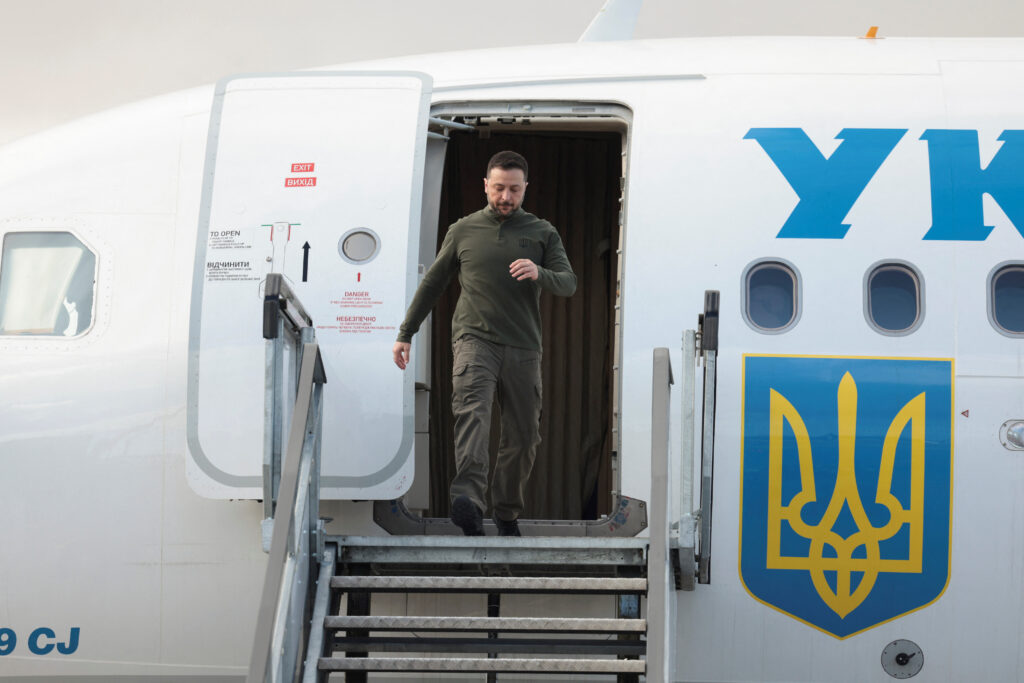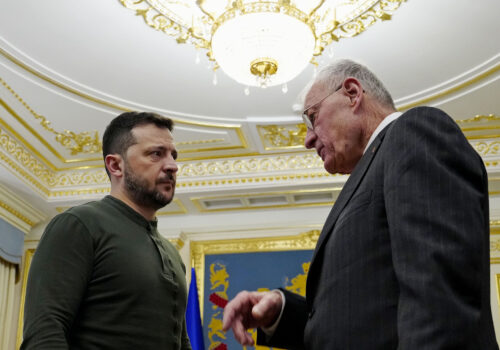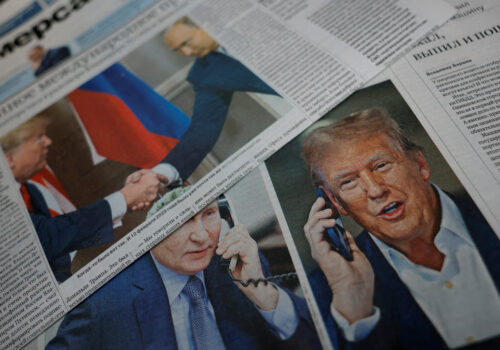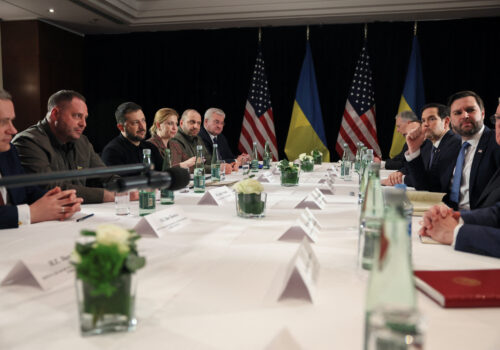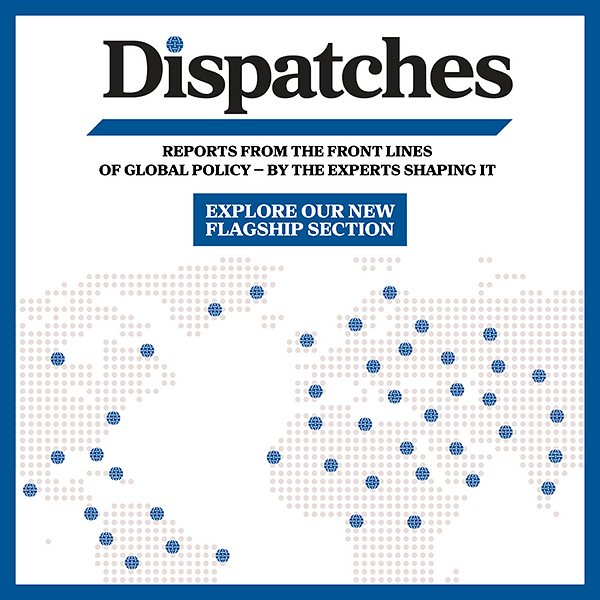KYIV—It was a crisp cold morning as our overnight train from Poland chugged into the Kyiv station. The still-white snow sparkled under the bright sun for this unusual train on an important day, February 24, the third anniversary of Russian President Vladimir Putin’s full-scale invasion of Ukraine.
The train was unusual for its passenger list. I was part of one group of perhaps sixty European and US former senior officials, national security experts, and journalists. We were arriving in Ukraine to attend a yearly conference put on by the Victor Pinchuk Foundation and Yalta European Strategy looking at the status and outlook of the war. More important was the second group on the train: heads of state and ministers from approximately thirty European countries and Canada, who were arriving to attend an event with Ukrainian President Volodymyr Zelenskyy and his ministers and to express solidarity with Ukraine. It was a strong symbol of support for Ukraine, but with the notable absence of the United States.
While current US officials did not attend the solidarity event, US policy and its implications were very much on the agenda at both events. Since his February 12 call with Putin, US President Donald Trump and his team have turned the Western world upside down by:
- launching peace talks with Russia without Ukraine (or Europe),
- talking with the Russians about a much broader agenda, in what looks like another attempted US “reset” with Moscow,
- labeling Zelenskyy a “dictator” responsible for the start of Russia’s full-scale invasion,
- refusing to label Russia an aggressor and working with Russia (and North Korea)—and against Europe and Ukraine—on resolutions on the invasion at the United Nations, and
- ruling out the deployment of US troops as peace enforcers to Ukraine and stating that NATO membership would be off the table for Ukraine.
These steps have prompted sharp criticism of US policy in the Ukrainian media and from many of the Ukrainian national security experts whom I met over three days in Kyiv. But the attitude of the senior Ukrainian officials I heard from was quite different. Yes, they were concerned about the possible implications of Washington’s policy steps. But they also saw opportunities to strengthen their position by reaching out to their European and Canadian partners and by finding a new basis for closer cooperation with the United States. The outreach to the Europeans culminated symbolically in the gathering of leaders in Kyiv on Monday, but also in new pledges of arms to Ukraine from the United Kingdom and other European nations.
More interesting is Kyiv’s interaction with Washington. Zelenskyy shrewdly included the prospect of cooperation in developing Ukraine’s critical and rare earth minerals in the “peace plan” he presented to the United States last year. The Biden administration looked at Ukrainian critical minerals as part of a global initiative—moving, given the complexity, at deliberate speed. The Trump team immediately understood the possibilities. China is the world’s greatest refiner of rare earth minerals, and it has not been shy about shutting off its supply to apply pressure to other nations. The United States needs urgently to find additional suppliers of rare earth and critical minerals.
It is remarkable that in his first month in office, Trump dispatched Treasury Secretary Scott Bessent to Kyiv to offer an agreement on Ukrainian natural resources. While commentators focused on the tough terms of the initial proposal, the Ukrainians simply said no and offered counter terms. The result was fast negotiations leading to an agreement within two weeks and plans for a Zelenskyy visit to the White House on February 28.
This is a reminder for Team Trump that Ukraine is a cooperative partner, and it comes as the new administration tries to nail down a sustainable peace in its first six months in office. Zelenskyy appears ready to enter talks with the United States and Russia and to offer concessions on territory that Trump wants to achieve a stable peace. But Putin still refuses any compromise. That was evident when, after Putin told Trump that Russia would not object to European troops in Ukraine as peace enforcers, Putin’s press spokesmen and foreign ministry repeated that Moscow would not accept such troops in Ukraine or the arming of Ukraine with Western weapons—Trump’s two suggestions to achieve a durable peace. What’s more, Moscow is insisting that Ukraine surrender additional land not occupied by Russian forces as part of any peace agreement.
In the course of negotiating the deal on Ukraine’s minerals and other natural resources, Zelenskyy sought security guarantees. Not surprisingly, he could not get them from the Trump administration as part of this agreement. But this deal gives Trump one more reason to ensure that the peace he brokers to end Russia’s aggression in Ukraine is durable.
Zelenskyy got additional good news in the past two weeks that should help meet his security needs. The Europeans finally got serious about Trump’s proposal that their troops should deploy to Ukraine as part of a peace deal. French President Emmanuel Macron hosted two days of meetings with other European leaders to discuss this concept; and he and British Prime Minister Keir Starmer are now discussing deploying as many as thirty thousand troops to Ukraine. Trump welcomed the idea, and the US president met with both Macron and Starmer this week. Their visits perfectly tee up Zelenskyy’s meeting with Trump on Friday.
All of these events together must remind the president of how much the United States, Europe, and Ukraine have in common. Zelenskyy’s visit highlights how far he has come from two weeks back, when Trump spoke of seeing Putin as many as three times in the near future, or even last week, when senior Russian and US officials were meeting in Riyadh. Yet now it is Zelenskyy, not Putin, in the Oval Office.
John E. Herbst is the senior director of the Atlantic Council’s Eurasia Center and a former US ambassador to Ukraine.
Note: The author’s travel to Kyiv was sponsored in part by the Victor Pinchuk Foundation.
Further reading
Wed, Feb 26, 2025
Digging into the US-Ukraine minerals deal
Fast Thinking By
Everything you need to know about the reported Trump-Zelenskyy economic pact on Ukraine’s natural resources.
Thu, Feb 20, 2025
What Europeans think of Trump’s approach to Ukraine (and what they might do next)
New Atlanticist By
European leaders are waking up to calls from the Trump administration to take the lead on security for Ukraine. Atlantic Council experts share what that might look like from Berlin to Vilnius.
Fri, Feb 21, 2025
The week that shook Europe—and the historic test ahead
Inflection Points By Frederick Kempe
Trump has an opportunity to cement his place in history and preserve the hard-won gains of the post–World War II era. But any perceived or actual sellout to Russia’s despot would leave an indelible stain US global leadership.
Image: Ukraine's President Volodymyr Zelenskiy arrives at Shannon airport ahead of a bilateral meeting with Ireland's Taoiseach (Prime Minister) Micheal Martin, in Shannon, Ireland, February 27, 2025. REUTERS/Emilija Jefremova
